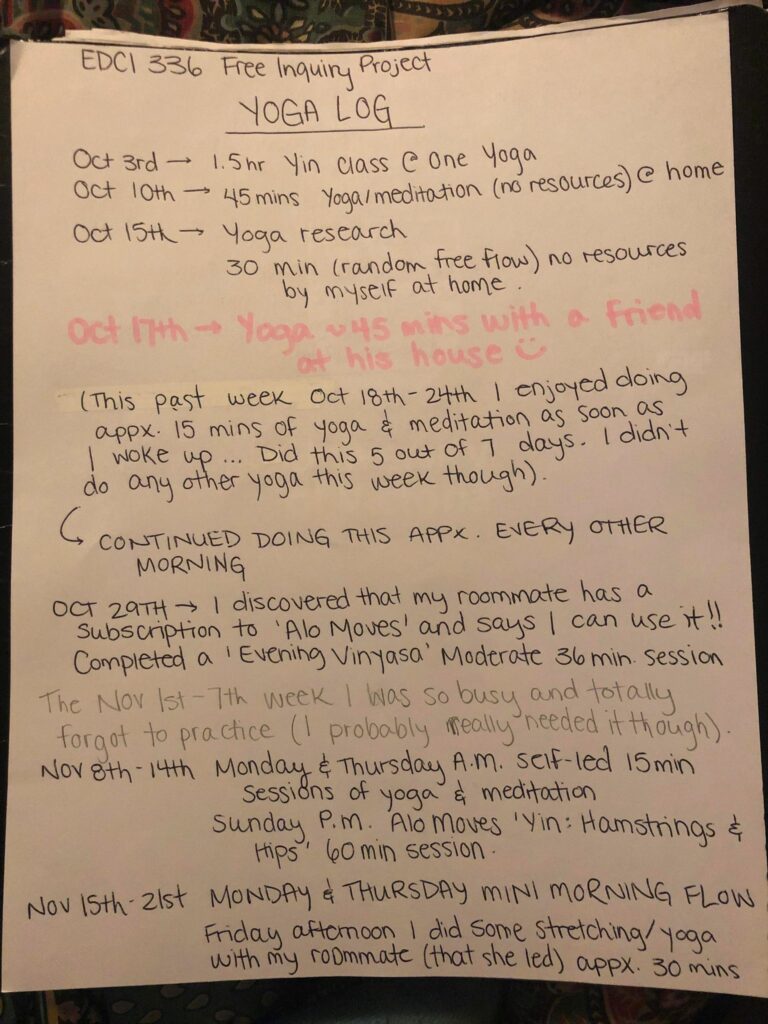
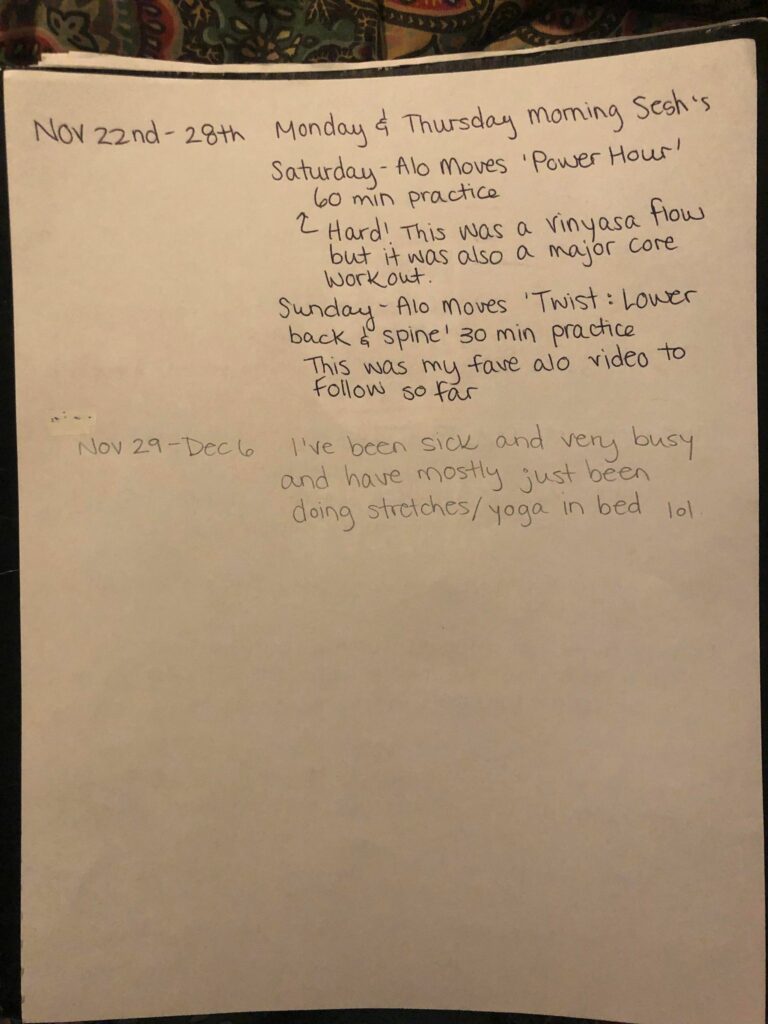

This is the category to apply to your Free Inquiry posts.
30-minute Friday afternoon fun flow with my roommate 🙂

Well… I didn’t do any yoga this past week 🙁 I had 98273 assignments due this week (or so it felt), my birthday was on Friday, I had a birthday party/gathering on Saturday, and today (Sunday) it is my best friend Logan’s birthday.
I have been extremely busy and this just kind of reiterates what I wrote in my last post – that keeping a rigid and regular practice just isn’t a priority for me right now. I still am very happy that I’m building a good resource base for when I do have the time though. And I do still practice more than I would if I wasn’t completing this inquiry project. I’ve notice that I am more mindful about when and how often I move my body. I tend to really slow down (requiring more sleep, less socializing, less activity and exercising) in the fall so I am grateful that this project has helped me stay healthy and somewhat active.
Photo by Надя Кисільова on Unsplash
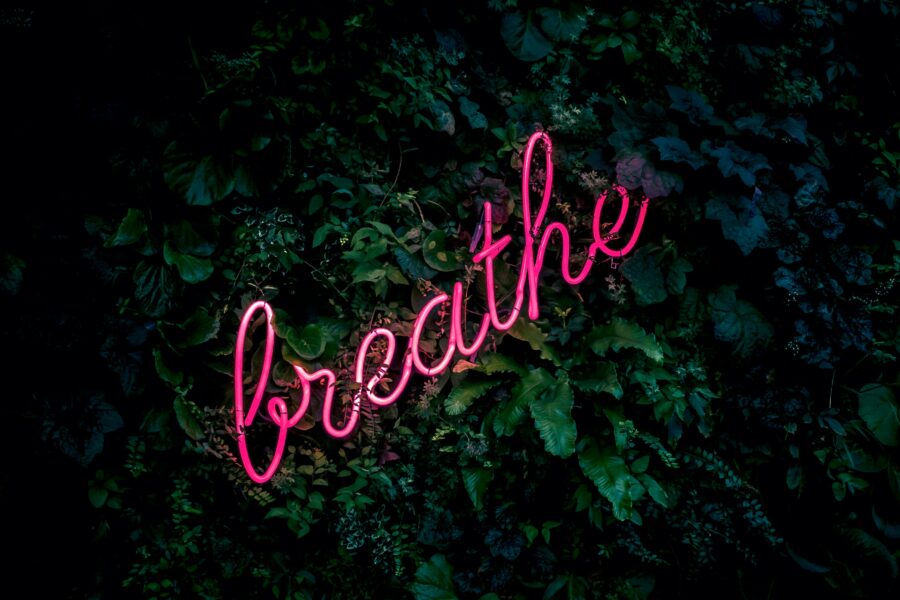
Okay so I haven’t been following my plan (which I wrote out in my first reflection post on September 30th). I have been practicing yoga but a lot more inconsistently than I would have liked. But I think I’m beginning to realize that I should want to keep a regular practice, it shouldn’t be forced. I am extremely busy between 6 classes at school, work, recently moving into a new house, requiring more sleep than I usually need as the seasons change, and trying to maintain my social life. And I am borderline broke so I will not be paying for a membership at a yoga studio anytime soon.
In the past two weeks I have had two intentional yoga sessions (appx. 30-minutes) and many half-assed attempts that just result in me doing a ~10 minute stretch and then getting distracted. I still enjoy these mini stretching/yoga/meditation sessions, but I want to stop beating myself up that they’re so short and meaningless feeling. They are still meaningful. I am still moving my body and it feels good. I think that this inquiry project is going to have to surrender to my busy life a bit and just take what it can get. I am still practicing yoga more than I usually would so that is a plus! And I feel like I’ve learned a lot so far.
In the past two weeks:
October 17th – I did yoga for 45 mins with my friend Logan after complaining to him that I need to do more yoga for this project. It was a nice and simple flow that he mostly led. We have done a few classes/workshops in the past where you do yoga with a partner (I think its been called Thai Massage Yoga?), so I am comfortable moving body near or touching his. I am able to go into a much deeper stretch in many positions with the help of another person.
I’ve done quite a few (3-5 times a week) “mini” morning sessions of stretching/yoga/meditation as soon as I wake up. It has been helping me wake up and get out of bed (although I sometimes spend half the time stretching in bed – but I will eventually end up on the floor). I want to continue this.
Earlier today though, something really exciting happened. I was talking to one of my roommates about this inquiry project and she mentioned to me that she has a subscription to Alo Moves and that I can use it anytime I want! Alo Moves is an application with hundreds of videos to follow, that fall under the four headings: fitness, mindfulness, skills, and yoga. They are all different lengths and difficulties. I am so happy about this! I completed one this evening and really liked it – it was called ‘Evening Vinyasa’ (36-minutes). It didn’t feel like I was forcing myself to go something I didn’t want to do. I think from now on I will be practicing at home, either by myself or with the help of Alo Moves. I enjoy following a yoga instructor that isn’t in the room, at random times when I have time in my busy schedule. I don’t want to keep trying to keep an extremely rigid yoga schedule when it’s probably just not possible for me at the moment. I’m going to continue doing “intentional” yoga – whenever I feel like I need to or want to, and hopefully this helps me practice more.
Photo by Fabian Møller on Unsplash
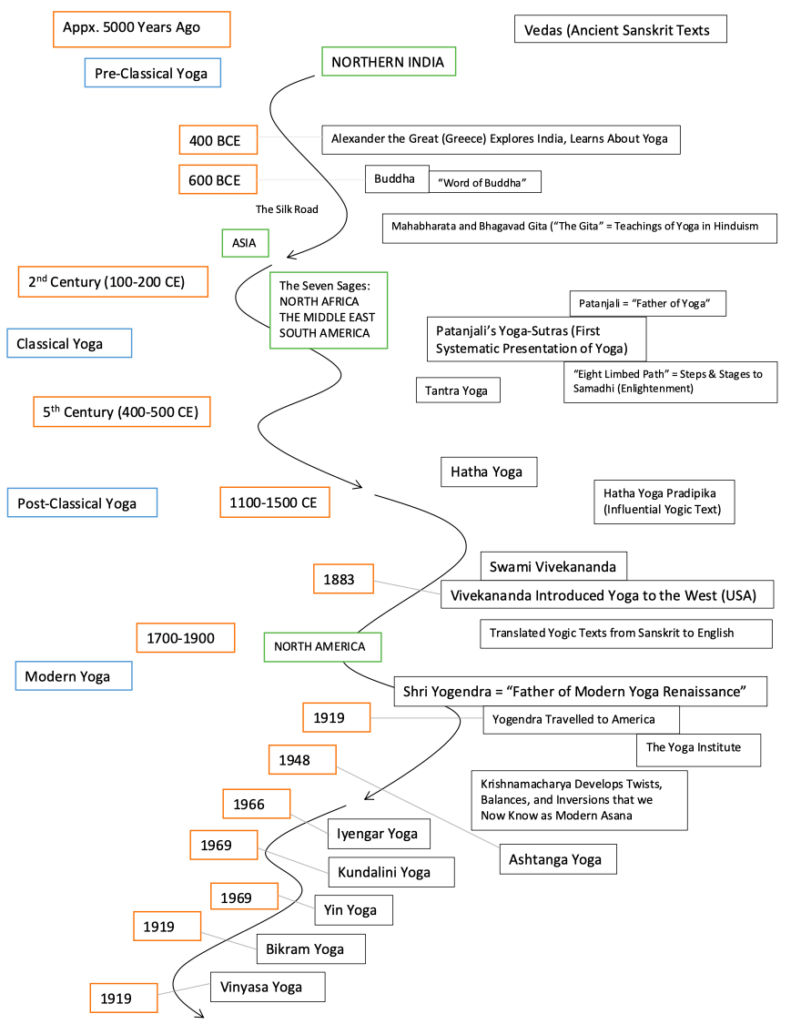
(Julia Bayne – CC BY)
This is a very brief timeline that I made on Microsoft Word after conducting tons of research and reading on the Westernization of yoga and the spread of yoga around the world.
Basavaraddi, I. (2015, April 23). Mea: Statements : In Focus Articles. Ministry of External Affairs, Government of India. Retrieved from https://mea.gov.in/in-focus-article.htm?25096%2FYoga%2BIts%2BOrigin%2BHistory%2Band%2BDevelopment.
Burgin, T. (n.d.). History of yoga. Yoga Basics. Retrieved from https://www.yogabasics.com/learn/history-of-yoga/
Google Arts & Culture. (n.d.). Explore the ancient roots of Yoga – Google Arts & Culture. Google. Retrieved from https://artsandculture.google.com/story/explore-the-ancient-roots-of-yoga/rAKCRDl92CPuJg.
Ratsamee, D. (2021). The westernization of yoga. University of Washington. Retrieved from https://thewholeu.uw.edu/2021/10/07/the-westernization-of-yoga/
Vinyasa Yoga School. (n.d.). The history of yoga (2020). Retrieved from https://vinyasayogatraining.com/resources/history-of-yoga
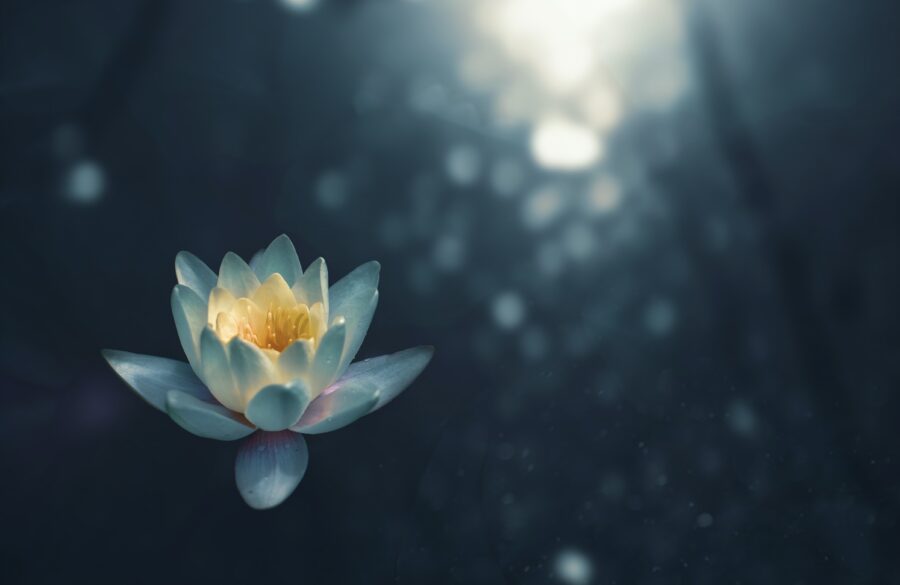
This week I conducted some research on the different kinds of yoga and how they are different. I wanted to dive deep into the history and origins of yoga as well, but soon realized (and remembered) that this is a huge topic involving so much cultural and religious history… and to be honest it was hard to find sources on yoga’s history that weren’t extremely “westernized” (written on American blogs and from the perspective of someone in North America). It felt inauthentic so I didn’t explore this topic much further.
| Type: | What I Learnt: | |
| Vinyasa | – Sanskrit word meaning “to place in a special way” – was adapted from ashtanga yoga in the 1980’s – classes are known for their fluid, movement-intensive practices – often to music – lots of variation between different classes, poses, sequences | |
| Hatha | – Sanskrit term describing all physical postures in yoga – in the West, hatha yoga refers to all styles of yoga that are grounded in practice (e.g., ashtanga, Iyengar) – good for beginners because it is usually slower paced | |
| Ashtanga | – translated from Sanskrit to “Eight Limb path” – based on ancient yoga teachings – rigorous and physically demanding – is always practiced with the exact same poses, in the exact same order (same sequence every-time) | |
| Iyengar | – founded by B.K.S. Iyengar – focuses on alignment – poses are generally held for longer – heavy reliance on props – good for people with injuries who need to work slowly and methodically | |
| Kundalini | – stems from the tantra yoga path – equal parts spiritual and physical – seeks to release the kundalini energy trapped in your body (at the base of your spine) – involves breathing techniques, and chanting and meditating on mantras | |
| Bikram | – named after Bikram Choudhury, developed 30 years ago – practiced in artificially heated, sauna-like rooms – Choudhury is pretty controversial though: he has faced sexual and harassment lawsuits and has also sued other studios who call themselves Bikram (because he trademarked his sequence and it isn’t always taught the exact way he says it should be) | |
| Yin | – Slow-paced and relaxed – Seated – Positions held for long period of time | |
| Anusara | – developed by American yogi John Friend in 1997 – based on the belief that we’re all filled with an intrinsic goodness – seeks to help students open their hearts, experience grace, and let their inner goodness shine through – movement focuses on spirals and how each body part should be moving – Friend created a unique system called the Universal Principles of Alignments – Friend resigned in 2012 after accusations of sexual misconduct and financial mismanagement | |
| Jivamukti | – founded in 1984 by Sharon Ganon and David Life – is mainly a vinyasa-flow-style incorporating Hindu spiritual teachings – emphasizes connection to Earth as a living being | |
| Restorative | – focuses on winding down and relaxing after a long day | |
| Hot | – largely the same thing as Bikram, except hot yoga usually deviates from Bikram’s sequences |
I also felt like I was doing a dis-service to yoga and it’s roots when searching for basic descriptions and information on the main types of yoga and only reading the blogs of middle to upper-class white women in California. I’m not sure why I feel so strongly about this… maybe because in my academic and social life I have had many conversations about cultural blindness, appropriation, stealing, colonialism, etc. etc. etc. But then again who am I to feel superior because I feel like I have more awareness – I am after all a middle to upper-class white woman on Vancouver Island that wants to learn about and practice yoga. Sigh. I do believe that these wonderful practices should be shared amongst all cultures. Much conflict in my brain. I really enjoyed learning about the different kinds of yoga though!
This morning (late-morning) I also did a 30-minute yoga session by myself in my room, without any resources. It consisted of mainly sun salutations, basic positions, and stretching. I somewhat focused on my breath but I had very little flow and felt distracted. Although I always enjoy stretching so it was still a positive experience.
Cook, J. (2007, August 28). Find your match among the many types of yoga. Yoga Journal. Retrieved December 8, 2021, from https://www.yogajournal.com/practice/yoga-sequences/not-all-yoga-is-created-equal/.
Gaiam. (n.d.). A beginner’s guide to 8 major styles of yoga. Gaiam. Retrieved December 8, 2021, from https://www.gaiam.com/blogs/discover/a-beginners-guide-to-8-major-styles-of-yoga#.
McGee, K. (2020, October 11). Types of yoga – breakdown of 11 major types. mindbodygreen. Retrieved from https://www.mindbodygreen.com/articles/the-11-major-types-of-yoga-explained-simply.
Photo by Zoltan Tasi on Unsplash
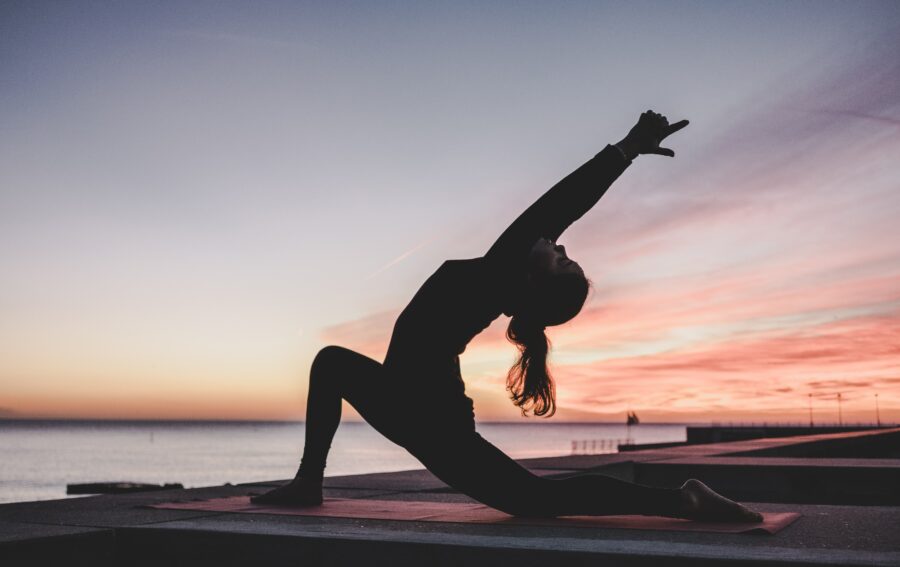
First off: Juggling six courses and having a regular yoga practice is going to be hard. But once I get used to it I think it will become more manageable.
This past week I researched different yoga studios in Victoria and Saanich (reasonable distances to my house near UVic) and here are my findings and thoughts:
After realizing (or remembering) how expensive yoga is, I think I will need to have a blend of studio and home yoga sessions to be practicing the amount that I want. This coming week I will try a class at CARSA. If I don’t like it then I will try Oxygen Yoga and Fitness, but if I do like it then I will purchase 4 weeks of classes and then research how I can incorporate a home practice (following yoga videos, channels) in with it.
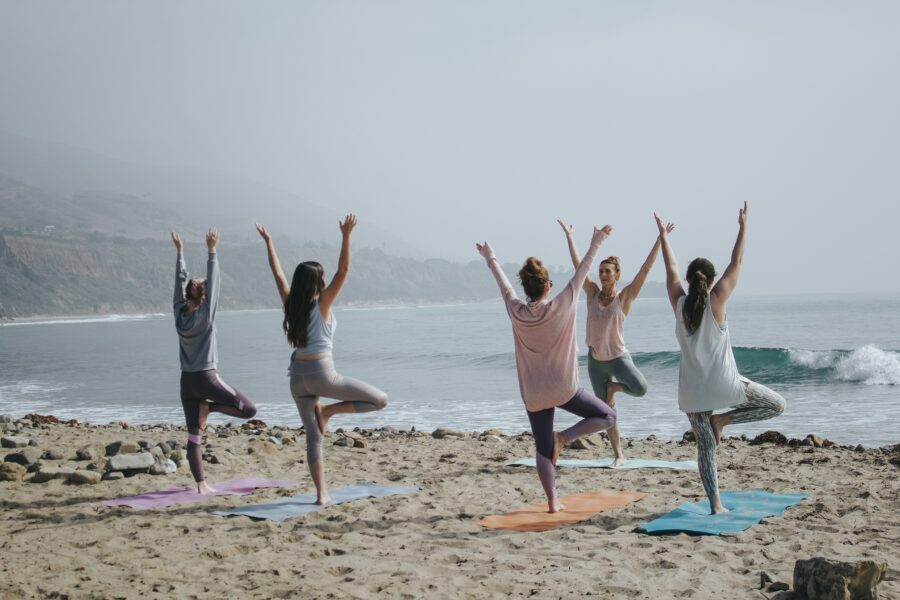
For my free inquiry project I am going to be exploring the world of yoga. More specifically, my goals by the end of this semester are to have a regular yoga practice (4 sessions a week) and to be able to do a headstand. I have always dabbled in yoga but I have never been able to keep a consistent practice. I’ve signed up for many discounted first month memberships at yoga studios around Calgary and Victoria, but I have never bought a membership further then that (they’re always to dang expensive). I know that there are a lot of online resources, some of which are free, but I haven’t put the energy or time into finding a website or video series that will work for me that I can practice alone at home. I want to take on this project for a couple different reasons:
To accomplish my goals, and because I like to set hard deadlines for myself, I’ve laid out the steps I am going to take each week. (I have only included the next month in this schedule and at the beginning of November I will lay out the steps I will take during the rest of the semester in a different blog post).
October 4 – 10
October 11 – 17
October 18 – 24
October 25 – 31
November 1 – 7
Featured image: Photo by Kaylee Garrett on Unsplash
Powered by WordPress & Theme by Anders Norén